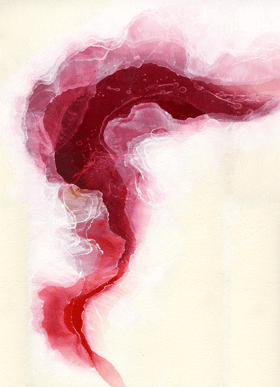
SOUNDS AND IMAGES
The pairing of sound and image is seminal to the work of New
York composer Stephen Dydo
and London painter Susan Haire. Through a shared appreciation of art and music, an appreciation based
on a transcendent dialog on the nature of their respective arts, their
collaboration begins with an investigation into an idea or object, such as
water. The resulting realizations in sound and space are a result of the dialog,
a fusion of individual creativities. Thus the realizations of La vita nuova
and riverrun
are conversations between two artists at a sub-artistic level, and the conversation
itself is what creates the art.
The overt structure of riverrun is this: Haire has
created a spatial environment consisting of groups of paintings. Each of these
groups describes a facet of the power of water. In each group, there is also a
sound environment—a piece of music explicitly involved in the vision of water
delineated by the group of paintings. In addition to this, there is a central
sonic construct, which is common to every group, radiating from the center of
the space.
The music explores the
layering of the images with its own layers of sound; in the installation, each
picture has its own sound source and its own characterization of the whole, with
all of the musical layers interacting within the space. So at any moment the observer is part of the commonality of the
central musical environment and also part of the specific musical and painterly
space of a local environment.
La vita nuova uses the same techniques of spatial music to lead the visitor through Dydo and Haire's reaction to the unique and seminal 14th century work by Dante. In it, he explored, both by narrative and poetry, the transformation of his life through an idealized and chaste love, which ultimately led him to compose The Divine Comedy. Dydo and Haire explore the different levels of Dante's vision through layers of counterpointed melodies and multiple, multi-layered paintings.
The marriage of sound and image
For a thousand years, the well-educated Chinese literatus was expected to be adept in the four major arts: shu (calligraphy), hua (painting), qin (playing the qin, a seven-string zither), and qi (Chinese chess). So painters and calligraphers were knowledgeable about the phrasing and gestures of the qin player, and in turn the qin players understood the movement and speed of the brush, the responsiveness of the ink and paper. In this way the literatus could immediately understand the connections between the processes of painting and playing. Dydo and Haire have developed that same kind of intimacy of technique to accompany their shared vision.
| Dydo: past work | Dydo: CV | Haire: past work | Haire: CV |
|
|
